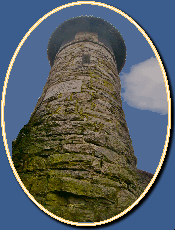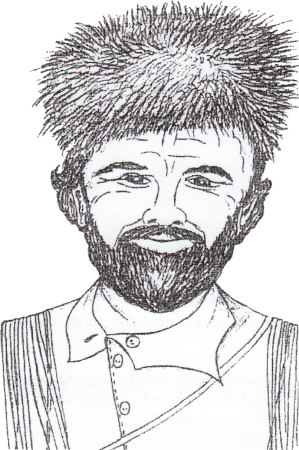1740 - 1787 an explorer who always found his way back to Milford
No matter how far a field Peter Pond traveled during his eventful lifetime, he always found his hometown of Milford as a place to which he could return.
Enlisting against his parents’ wishes at age 16 in 1756 to fight in the French and Indian War, he took part in four different campaigns. At the end of each he would return home as the oldest in a shoemaker’s family of eight children.
Since Milford was and is a seaport town, Pond took a trading voyage to the West Indies in 1761 at age 21. That was the same year his mother died, and he found himself as head of the large family while his father apparently dropped shoemaking and went off trading furs in the Detroit area.
In 1762, he married Susanna Newell and soon had two children, Peter Jr. and Elizabeth. He stayed in Milford three years, a period that turned out to be, as stated in his colorful phonetically spelled memoirs “the ondlay three years of my life I was three years in one plase since I was sixteen years old up to sixtey.” He followed his father into the fur trade, a profession he kept for the rest of his life until retiring to Milford in 1790.
Pond first started trading along the Mississippi River valley and found he was good at it. He had an affinity for dealing with the Indians with whom he traded their furs for his trinkets and tools, and a love of living outdoors, even through harsh winters. In 1775, he headed for Canada where the colder winters made for thicker furs. In 1778, Pond was chosen among a group of traders who had wintered along the Saskatchewan River to gather all their trade goods and push out of the Hudson’s Bay watershed where the rivers flowed east, into the Athabasca River watershed where the rivers flowed north and west, and where no white man had ever been.
With four birch bark canoes and 16 men, Pond’s brigade crossed the torturous 12-mile Methye Portage that connected the two watersheds carrying packs and boats on their backs. In establishing his first trading post on the Athabasca River just south of the huge Lake Athabasca, he was the first white man to settle so far west at the time, about 400 miles due north of present-day Montana. This venture produced the thickest and richest fur pelts anyone had ever seen. Indians were eager to trade, happy that the white men had come to them. Before this, Indians traveled great distances east to trade with the white man along the Saskatchewan River and as far as Hudson Bay.
Pond brought back to Montreal as many furs as his four canoes could carry, which was only half the amount gathered, the rest left behind in an Indian lodge to be retrieved the following season. He gathered a group of Montreal businessmen who saw an opportunity to cash in on these rich furs, including the highly sought beaver pelts that went into making the popular beaver hats of the time. This was the start of the North West Company that was soon to become a stern competitor with the venerable Hudson’s Bay Company that had been trading in the Hudson Bay watershed since 1670.
But Pond, a man of short temper, felt slighted after being offered only one share as the company expanded around 1785. He left Canada for Milford to ponder his next move. There is no record of how he was received by his wife and children after being away for so long.
It was around this time that Pond started drawing crude but decipherable maps, considered the first of their kind to show rivers and mountains west of Hudson Bay. In Milford he was told by seafaring cronies of the voyage of British Capt. James Cook up the West Coast of North America and finding what looked like the outlet of a large river around the same latitude as Athabasca Post. For several hundred years, explorers had been looking for a Northwest Passage as some kind of navigable waterway that crossed North America to the Pacific Ocean and riches of China and the East Indies, which Columbus had originally been trying to reach. Pond concluded this wide opening that cut deep into the land must be the outlet of the large river he had seen emptying out of Great Slave Lake just north of Lake Athabasca.
Pond set to work on a map that included showing a river connecting Great Slave Lake and the apparent outlet that Cook had found. He went to New York City, the nation’s capital from 1785 to 1790, and stated his case to the young U.S. Congress. He presented his map showing the area from Hudson’s Bay to the West Coast and the river he believed to be the mythical Northwest Passage connected to the Pacific Ocean. He offered to lead an expedition down that river to the ocean, thereby claiming that river and all of the West Coast for the young United States. The Congress turned down his proposal as too ambitious to take on for a young nation so low on funds. Pond left his map with Congress and returned to Canada and the North West Company where he knew he still could get work, accepted the one share as better than nothing and continued on at Athabasca Post as he had before.
Pond was 45-years-old in 1785 and showed no sign of slowing down even though younger traders were starting to retire from such a strenuous profession. Hearing of the richness of Athabasca furs, other traders were starting to operate in the area, which made tensions mount. Pond had two unfortunate run-ins during these tense times. In March 1782, before leaving for Milford, he and his clerk, Toussaint Le Sieur, had been heard arguing inside a cabin near Lake La Ronge, Saskatchewan, with a rival trader, Jean Etienne Waden. A shot rang out in the cabin, and others ran in to find a gun on the floor and Waden bleeding profusely from a leg wound. He died a few hours later without saying who shot him. No one had actually seen Pond and LeSieur commit the act. An inquiry later took place in Montreal, but since the crime had occurred where no court had jurisdiction, the two were never convicted. But now a cloud of suspicion was hanging over Pond as head trader for the area.
Then in 1786, Pond was at his Athabasca Post while some miles away a fight took place between Pond’s men and a rival band of traders. A shot rang out and one of the rival traders, John Ross, was dead, “killed in a scuffle with Pond’s men,” as the report spread from mouth to mouth around the trading regions of Canada. This second killing under Pond’s watch made officers back east take punitive action. To calm tensions down between the two rival trading groups involved, North West Company merged with XYZ Company and a man from that latter group was sent to replace Pond at Athabasca. The man was a young, fiery, ambitious trader named Alexander Mackenzie. Pond accepted his replacement with magnanimity, knowing his time in the frontier had come to an end and he would never be able to lead an expedition to the West Coast. Pond spent the winter telling Mackenzie all he knew about the area, showed him a map of the West he had been preparing for the Empress Catherine the Great of Russia, and related his theory that the Great River emptying Great Slave Lake connected to the Pacific Ocean. This, he said, could be the closest anyone would come to a Northwest Passage as well as the best way to get the rich Athabasca pelts out to the West Coast for trade with Russia, China and the Indies.
Pond left Athabasca for good in the spring 1788, leaving Mackenzie fired up to conduct his own exploration. In Montreal, Pond started living the good life, squandering his fur trade earnings and basking in the glow as the one who pointed Mackenzie to become the first white man to the Pacific overland across North America. In 1789, Mackenzie led an expedition down that river from Great Slave Lake only to find that after heading west it swung north and emptied into the Arctic Ocean. When news hit Montreal in 1790 that Mackenzie did not reach the Pacific and called the river that Pond suggested the River of Disappointment, Pond was ostracized. He left Canada and returned to Milford for good. The river, second longest in North America, was later named the Mackenzie River.
Back in Milford, Pond’s wife had died and he took up residence with his daughter, Elizabeth. He soon became an object of curiosity if not admiration after returning from places so far away. But in a likely touch of sarcasm because he was so long in British territory, he started to be called “Sir Peter.” Admirers included Yale College President Ezra Stiles, who recorded in his 1790 diary that Pond visited him twice to relate his experiences in far off Canada. Stiles also made a copy of Pond’s map, which is still on file in Yale University’s Beinecke Rare Book and Manuscript Library. There is no record that Pond was ever officially dubbed a knight.
Mackenzie, still fired up over Pond’s theories about a river to the sea, tried again in 1793 and this time he made it. He did so through a series of rivers from the Peace leaving Lake Athabasca, to the Parsnip then a trail through the Rocky Mountains and finally the Bella Coola River to the Pacific. He wrote a best selling book about his travels for which he was knighted by King George III and lived in prosperity until his death.
It was Mackenzie’s book that pushed President Thomas Jefferson to launch the Lewis and Clark Expedition to forestall any more British incursion on the West Coast. Therefore, Pond can be seen to be indirectly responsible for the Lewis and Clark Expedition.
But things did not go well for Pond during his later years in Milford. Taking Mackenzie’s lead and probably needing a way to bring in money after squandering most of it in Montreal, Pond wrote his own memoirs. With many phonetic misspellings and without a ghostwriter to clean it up as Mackenzie had, the journal was simply passed down through several generations of Ponds until Mrs. Nathan Gillette (Sophia) Pond saved it from being ripped up for stove kindling in 1867 in the house of Gov. Charles Hobby Pond on Broad Street. The house is no longer there but a plaque marks the spot.
How much of the journal went into the fire is unknown but it ends abruptly at 1775, just before entering his glory years in Canada. The journal was finally published with phonetic misspellings retained in a 1906 issue of Connecticut Magazine, then in 1935 and 1965 by the Minnesota Historical Society with many annotations. A family member donated the journal in 1947 to the Manuscripts and Archives Division of Yale University Library.
Pond died of consumption (tuberculosis) at age 67 in 1807 and was buried in Milford Cemetery. But the location of his grave is unknown as no headstone remains



